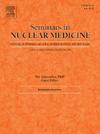Artificial Intelligence for Tumor [18F]FDG PET Imaging: Advancements and Future Trends - Part II
IF 5.9
2区 医学
Q1 RADIOLOGY, NUCLEAR MEDICINE & MEDICAL IMAGING
引用次数: 0
Abstract
The integration of artificial intelligence (AI) into [18F]FDG PET/CT imaging continues to expand, offering new opportunities for more precise, consistent, and personalized oncologic evaluations. Building on the foundation established in Part I, this second part explores AI-driven innovations across a broader range of malignancies, including hematological, genitourinary, melanoma, and central nervous system tumors as well applications of AI in pediatric oncology.
Radiomics and machine learning algorithms are being explored for their ability to enhance diagnostic accuracy, reduce interobserver variability, and inform complex clinical decision-making, such as identifying patients with refractory lymphoma, assessing pseudoprogression in melanoma, or predicting brain metastases in extracranial malignancies. Additionally, AI-assisted lesion segmentation, quantitative feature extraction, and heterogeneity analysis are contributing to improved prediction of treatment response and long-term survival outcomes. Despite encouraging results, variability in imaging protocols, segmentation methods, and validation strategies across studies continues to challenge reproducibility and remains a barrier to clinical translation. This review evaluates recent advancements of AI, its current clinical applications, and emphasizes the need for robust standardization and prospective validation to ensure the reproducibility and generalizability of AI tools in PET imaging and clinical practice.
人工智能在肿瘤中的应用[18F]FDG PET成像:进展和未来趋势-第二部分。
人工智能(AI)与[18F]FDG PET/CT成像的整合不断扩大,为更精确、一致和个性化的肿瘤评估提供了新的机会。在第一部分的基础上,第二部分探讨了人工智能驱动的创新在更广泛的恶性肿瘤中的应用,包括血液学、泌尿生殖系统、黑色素瘤和中枢神经系统肿瘤,以及人工智能在儿科肿瘤学中的应用。人们正在探索放射组学和机器学习算法,以提高诊断准确性,减少观察者之间的差异,并为复杂的临床决策提供信息,例如识别难治性淋巴瘤患者,评估黑色素瘤的假性进展,或预测颅外恶性肿瘤的脑转移。此外,人工智能辅助的病变分割、定量特征提取和异质性分析有助于改善治疗反应和长期生存结果的预测。尽管取得了令人鼓舞的结果,但不同研究的成像方案、分割方法和验证策略的可变性继续挑战着可重复性,并且仍然是临床转化的障碍。本文评估了人工智能的最新进展及其目前的临床应用,并强调需要强有力的标准化和前瞻性验证,以确保人工智能工具在PET成像和临床实践中的可重复性和普遍性。
本文章由计算机程序翻译,如有差异,请以英文原文为准。
求助全文
约1分钟内获得全文
求助全文
来源期刊

Seminars in nuclear medicine
医学-核医学
CiteScore
9.80
自引率
6.10%
发文量
86
审稿时长
14 days
期刊介绍:
Seminars in Nuclear Medicine is the leading review journal in nuclear medicine. Each issue brings you expert reviews and commentary on a single topic as selected by the Editors. The journal contains extensive coverage of the field of nuclear medicine, including PET, SPECT, and other molecular imaging studies, and related imaging studies. Full-color illustrations are used throughout to highlight important findings. Seminars is included in PubMed/Medline, Thomson/ISI, and other major scientific indexes.
 求助内容:
求助内容: 应助结果提醒方式:
应助结果提醒方式:


